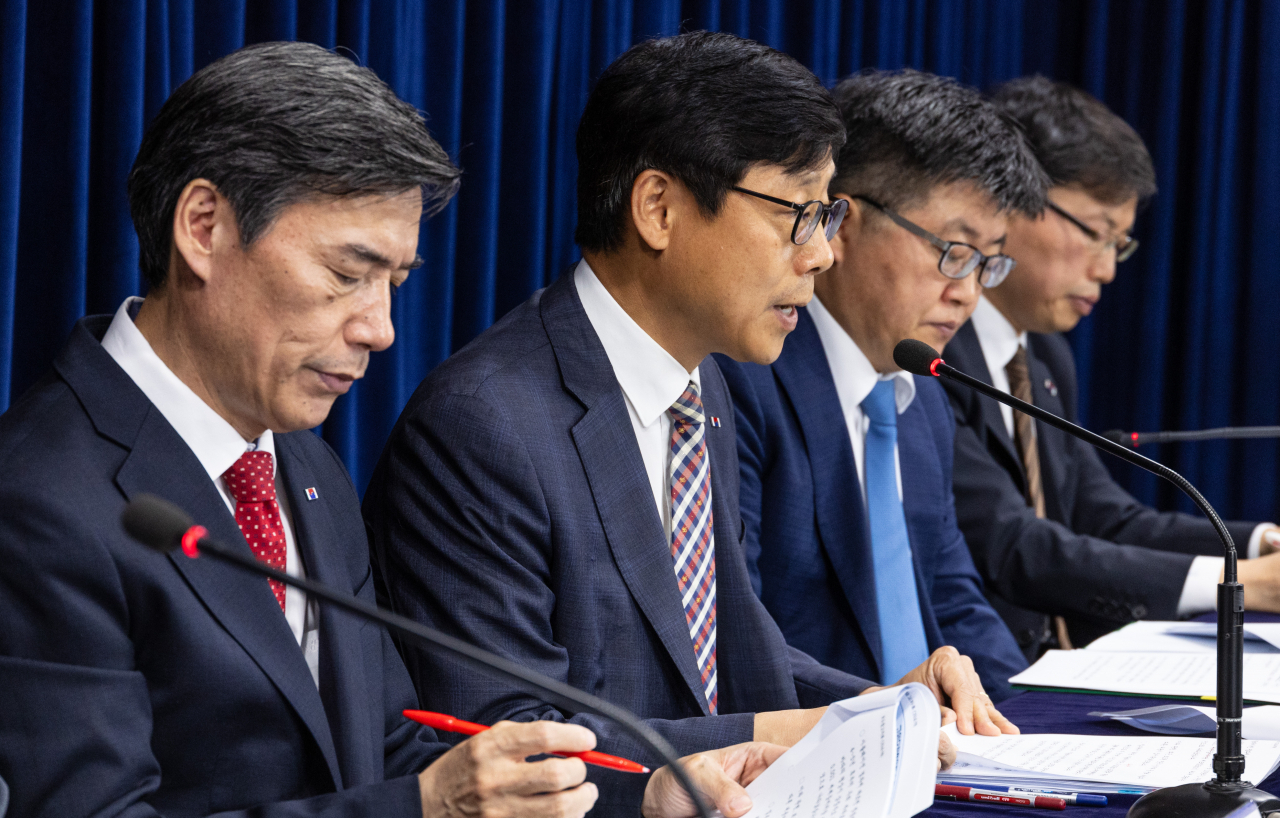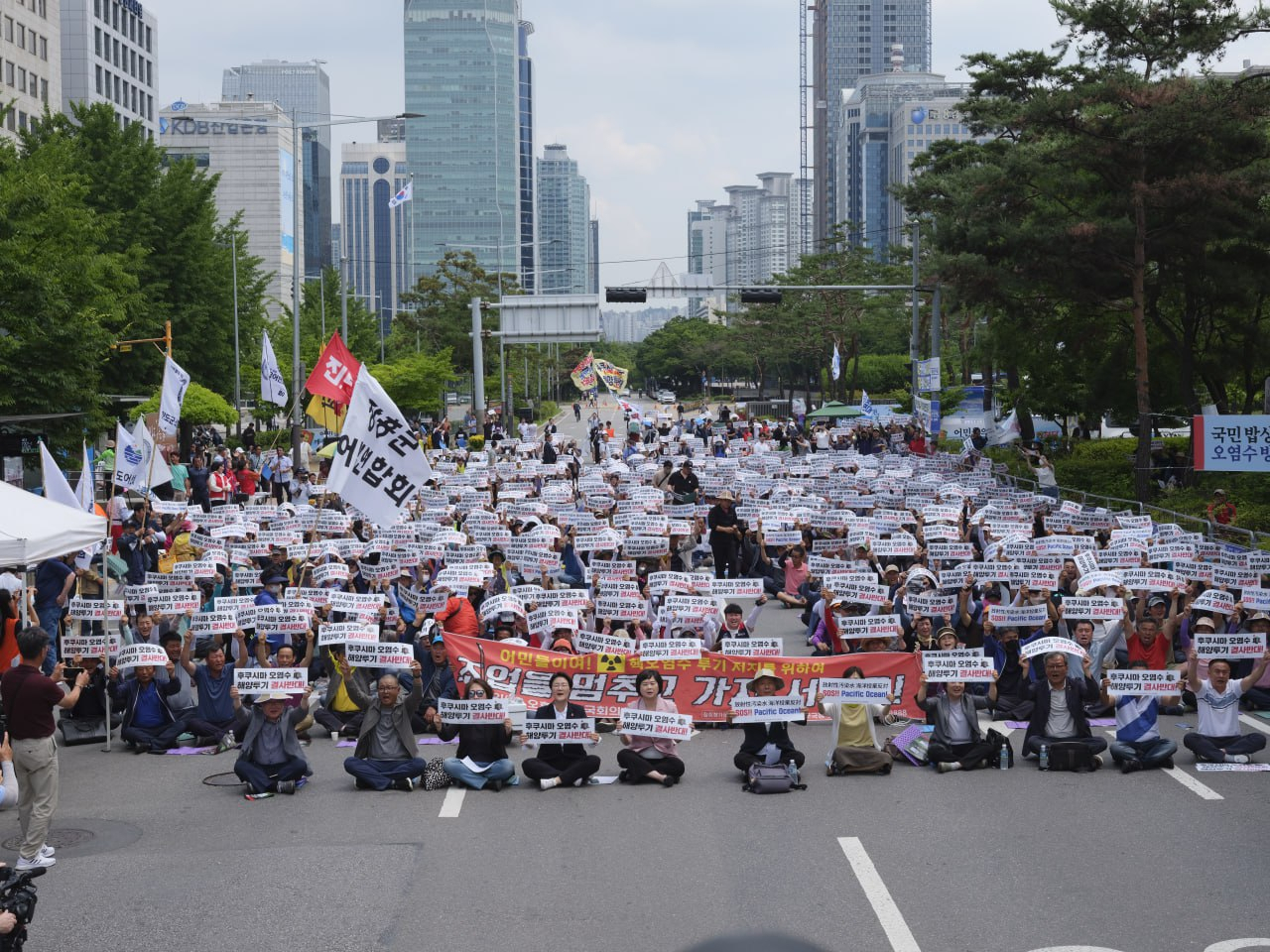 |
Inspectors at the Gyeonggi Institute of Health Environment conduct a radiation test on seafood in Suwon, Gyeonggi Province on Thursday. (Yonhap) |
Concerns are growing among South Koreans over the safety of seafood ahead of Japan's release of wastewater from the disabled Fukushima Daiichi nuclear plant into the ocean over the course of 30 years, despite “scientific” assessments which indicate that seafood consumed by Koreans has been, and will continue to be, safe.
Some consumers have already started to hoard goods like sea salt out of fear that clean marine products might no longer be available, upon news that the contaminated water will likely be coming their way after several years of circulating in the Pacific Ocean.
In a country where a single person is estimated to consume nearly 70 kilograms of seafood each year, news about hoarding has only added to people's fears.
A woman surnamed Kim, a 36-year-old who just opened a holiday rental property in the southern part of Korea, said she would no longer enjoy the happiness that comes from eating seafood.
“I don‘t feel like buying either local or imported seafood because I don’t want to die from a serious illness,” she said.
"Holiday rental property operators here might start to feel the heat when the peak season starts in July. ... I fear that our beloved coast might turn into a toxic place."
Fishers say the news doesn't bode well for their livelihood, as Korean consumers will continue to lose their appetite for local seafood if public fear persists over the Fukushima wastewater release.
"The livelihood of fishers is being threatened," said Joo Hae-gun, chairman of the National Fisheries Federation which represents over 100,000 fishers in Korea, at a rally held on June 12 near the National Assembly.
Korea is just one of Japan's neighboring countries that are keeping a close eye on the crippled Fukushima Daiichi nuclear power plant's upcoming release of over 1.3 million cubic meters of contaminated water into the sea after treatment.
A task force under the International Atomic Energy Agency is set to release a final assessment, likely before the end of June, over whether Japan's water treatment technology would work to keep the level of radioactivity below the regulatory guideline.
Awaiting the IAEA announcement, Seoul has been holding daily briefings since Thursday -- largely in favor of Japan's planned Fukushima wastewater disposal -- to address the "lack of information or spread of misinformation" that intensifies public fear, said Park Ku-yeon, first vice minister of government policy coordination.
 |
This photo shows high-ranking government officials, including Song Sang-keun (second from left), vice minister of Oceans and Fisheries, attending a daily press briefing Monday, which marked a third since Thursday, designed to ensure safety of Japan's plan to release radioactive wastewater at the sea. (Yonhap) |
During the daily briefings, Seoul has sought to reassure consumers, saying that Korean marine products from the affected waters would be tested to prove they are safe, and that Seoul would continue to steer clear of contaminated seafood imports from Japan.
Seoul has echoed the IAEA's view that tritium was the only radionuclide out of over 60 found in the contaminated water that cannot be adequately filtered out of Fukushima Daiichi power plant's Advanced Liquid Processing System. When the wastewater -- treated through the ALPS technique and diluted with sea water before disposal -- reaches the Korean sea, the radiation exposure Koreans will experience will be much lower than that of X-rays.
Data presented at the briefings indicate that the radioactive water will reach the seas off Korea in about four to five years after the release, containing one 100,000th of tritium found in normal levels. As a result, Koreans could be exposed to 0.00003 millisievert of radiation as the treated water containing tritium reaches the sea near the Korean Peninsula, lower than the 0.1 millisievert when using a radiograph, according to research by the International Commission on Radiological Protection.
Once exposed to tritium, it can pose health concerns in both humans and non-human biota. Researchers also found a correlation with DNA damage if internalized, according to a 2023 paper led by Maria Florencia Ferreira, a marine biologist at the University of Plymouth in England.
Other long-lived radioisotopes with health hazards, such as strontium-90, caesium-134 and caesium-137, were found to have shown a lower activity concentration of 1 becquerel per liter, while that of iodine-129 could amount to 2 becquerel per liter in the worst-case scenario, according to IAEA's preliminary report in May.
It added that Japan's plan to dump the wastewater into the sea was a more viable option than disposing of it through the air, given that radioactive elements become harder to contain once the water evaporates. Moreover, burying the wastewater on Japanese soil proved to be virtually impossible after Japan started reviewing the dumping method in 2018.
The data from the briefings also showed that the concentrations of radioactivity in all 29 test spots in waters off the Korean Peninsula were less than before the Fukushima Daiichi power plant meltdown in 2011. Despite this, the government has pledged to introduce more radiation detecting devices for fishers.
 |
This photo shows fishermen at a demonstration to protest Seoul's failure to oppose Japan's plan to dump wastewater at sea on June 12 near the National Assembly. (Courtesy of Civil Society Organizations Network in Korea) |
As for seafood imports, the government has revealed that no irregularities have been found in seafood consumed by Koreans through over 75,000 inspections during the production and distribution stages.
Japanese seafood imports in 2022 hit the highest point since the Fukushima meltdown, according to official customs statistics. Japanese seafood imports were worth a combined $174.2 million last year. The annual imports, valued at $212.2 million, drastically fell to $153.9 million in 2011 and hit a low in 2014 at $91.2 million, following a leakage in 2013.
The Ministry of Oceans and Fisheries has been conducting all-out inspections of all imported seafood to check for any fraudulent designation of country of origin labels. It said the toughened measures will persist for the time being.
Korea has banned imports of seafood from eight Japanese prefectures -- Aomori, Miyagi, Iwate, Fukushima, Ibaraki, Tochigi, Gunma and Chiba -- in the wake of the 2013 wastewater leakage incident.
Japanese seafood from other areas also have to meet stringent criteria. For example, imported seafood containing more than 100 becquerels per liter of radioactive caesium are not allowed to be sold on the Korean retail market. Products that fail to meet the requirements will be sent back for additional certificates. There were 136 such cases from 2011 to 2013 and zero cases were reported since 2014, according to the government.
Red flags, however, were also raised during the briefings. There were eight reported cases of a breakdown in the ALPS system over the past 10 years.
"What the government does is beyond its responsibility," Chung Bum-jin, a nuclear engineering professor at Kyung Hee University, told The Korea Herald.
The government is trying to address the problems that might arise later on, such as a decline in seafood consumption, he said, adding that the safety of seafood is scientifically ensured.
"Radioactive water leakages due to the 2011 Fukushima meltdown had no effect on the seas off Korean coasts," he said.
However, not all nuclear experts are in favor of the water discharge plan.
To Lee Jeong-yoon, an independent nuclear engineering inspector who leads a civic group -- Nuclear Safety and Future -- pointed out that Japan's past "scientific" claims were already proven to be false.
"Before the 2011 reactor meltdown, Fukushima Daiichi boasted that there would only be three chances of any reactor core breakdown in 10 million years based on its own probabilistic safety assessment, but all the reactors were destroyed in just five years," Lee told The Korea Herald.
"When (Japan) talks about science, they are bringing up what is trapped in ideology and (political) interest. ... That's the science that the Korean government is relying on."
 |
This photo, taken Monday, shows a notification in a hypermarket in Seoul that salt is no longer available for purchase. (Yonhap) |
The growing ripples of fear over seafood safety have only piled on more pressure onto those in the fishery and aquaculture industries in Korea, who have vehemently opposed the plan.
Coarse sea salt retail prices surged nearly 20 percent from the previous year, according to data from the Korea Agro-Fisheries & Food Trade Corp.
The latest developments have unnerved fishers across Korea. An advocacy group of coastal fishers earlier in June filed a complaint with the police against Suh Kune-yull, a nuclear engineering professor emeritus at Seoul National University, who was accused of instigating public fear with his media comments over the release of Fukushima wastewater.
"What happens when Japan starts dumping its wastewater? You name it. Fish that we got in a rough sea, seaweed that we grew day and night, oysters, abalone and other shellfish. They won't sell in the Korean market and fishers will be in trouble," said Park Jeong-hee on stage at the rally on June 12, who identified himself as a fisherman from South Jeolla Province.
In 2021, South Korea produced 379.6 million metric tons of seafood. Excluding freshwater and overseas fisheries, Korea generated 323.1 million tons of seafood -- either through offshore fisheries or coastal aquaculture.
To brace for the looming water disposal, the government has allocated some 369.3 billion won ($288.4 million) this year to the Fishery Ministry, up 2.3 fold compared to the previous year's budget, to address concerns over the Fukushima water release. Given the size of Korea’s marine produce and the anticipated damage proportionate to the size, more of the government budget should be deployed to seek practical solutions, according to a March report of the National Assembly Research Service.
"We ask policymakers to help our livelihood remain uninterrupted and let nature take its course," said Yang Jung-bok, a fisherman from Busan, during the rally.







